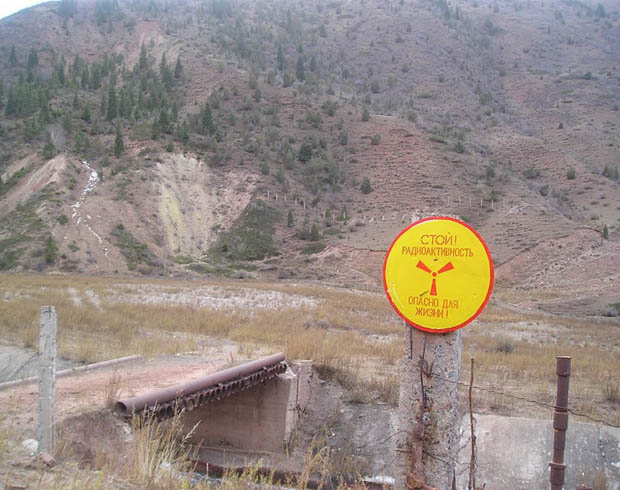
Uranium Waste in Central Asia Presents Serious Security Challenges
Publication: Eurasia Daily Monitor Volume: 10 Issue: 13
By:

News agencies reported on January 10 that the European Union had earmarked 2.1 million euros ($2.8 million) for Kyrgyzstan to administer and rehabilitate the country’s former uranium-producing site in Min-Kush in central Naryn province as well as the uranium tailings (waste by-products of uranium mining) at Shekaftar in Jalal-Abad province as part of the EU-Kyrgyzstan annual nuclear security program. The decision comes about a month after the EU announced its intention to provide Tajikistan with 2.4 million euros ($3.2 million) to conduct a technical and economic assessment of the two largest spent uranium storage facilities in the country’s north (www.24kg.org, January 10; www.mir-politika.ru, December 19, 2012).
The Central Asian republics of Uzbekistan, Kazakhstan, Tajikistan and Kyrgyzstan lack financial resources and to a varying degree suffer from inadequate regulatory, technological, and security practices that are needed to properly and effectively manage their uranium waste sites.
Lack of adequate uranium waste storage practices in Soviet times is a big factor explaining today’s dire state of uranium dumps scattered across Central Asia. Some studies estimate that the Central Asian region is home to more than 800 million tons of uranium waste. Forty percent of this waste contains hazardous radioactive elements, posing serious risk of region-wide contamination if adequate protective and rehabilitative measures are not put in place. Failure to address related issues would continue to threaten people’s lives while undermining efforts of regional countries to develop agricultural, tourism and export industries (www.m.gezitter.org, October 25, 2012; www.pressa.tj, July 18, 2012; www.rus.azattyq.org, July 3, 2009).
In many instances, communities living near such radioactive sites are poorly aware of related health dangers, often collecting scrap metal or grazing cattle on contaminated land and using contaminated water. Some uranium tailings are located near populated areas that are prone to earthquakes or landslides and are close to rivers that cross Central Asian borders and supply water from upstream Tajikistan and Kyrgyzstan to downstream Uzbekistan and Kazakhstan. Many of the region’s uranium dumps are also either poorly guarded or unsecured at all, prompting some to express concern that terrorist and criminal groups can get their hands on radioactive material that can be used to manufacture “dirty” bombs (www.atomic-energy.ru, December 21, 2012; www.fergananews.com, May 16, 2009; www.rus.ruvr.ru, October 26, 2012; www.rus.azattyq.org, July 3, 2009; www.centrasia.ru, October 20, 2004).
In Kyrgyzstan alone, there are 75–90 radioactive waste sites with a total volume anywhere between 145 million and 500 million cubic meters. Twenty-nine of these sites are uranium dumps, most of which are located in zones prone to flooding, earthquakes and landslides. Currently, Kyrgyzstan’s authorities focus their clean-up efforts on tailings in the villages of Min-Kush in the Naryn province, Ak-Tuz in the Chui province, Kaji-Sai in Issyk-Kul province, and the towns of Maili-Suu and Shekaftar in Jalal-Abad province (KyrTag News Agency, January 10; www.rus.ruvr.ru, October 26, 2012; www.m.gezitter.org, October 25, 2012; www.trend.az, April 28, 2009).
Tailings in Ak-Tyuz, for instance, are the legacy of a local factory that produced rare earth metals for the Soviet space industry in the town once populated by 16,000 people. It was here that a 1964 earthquake destroyed a protective dam and mudflows washed away one of the tailing pits, resulting in contamination of the Kichi-Kemin River and vast stretches of land with more than half a million cubic meters of radioactive waste containing thorium and heavy metals. The waste spread to about 40 kilometers, allegedly up to Kichi-Kemin’s influx into the Chu River in Kazakhstan (www.trend.az, April 28, 2009). Djumabek Abakiro, who used to work at the factory and now leads a public fund, “The Future for Nature,” cites “huge apples” that grow downriver to press the case for urgently neutralizing toxic elements and rehabilitating the tailings—a task that may cost authorities at least $3.5 million (www.trend.az, April 28, 2009).
Tajikistan, in turn, is home to more than 450 million tons of uranium waste. Absent proper rehabilitation, the waste poses serious dangers to communities within and outside national borders. Ten of the country’s uranium tailings are in proximity to Kairakkum reservoir and the river Syr Darya, which flows across a long stretch of the Central Asian region. The two largest uranium dumps are at Tabashar (the Soviet Union allegedly used the locally produced uranium at this secretive site to create the country’s first atomic bomb) and at Degmai. The uranium tailings at Degmai, for example, contain approximately 36 million tons of uranium waste and are feared to be the cause of a rising number of oncological and other illnesses reported in the area (www.mir-politika.ru, December 19, 2012; www.fergananews.com, May 16, 2009).
The above-cited facts and observations were most surely on the minds of representatives of Kazakhstan, Kyrgyzstan, Tajikistan, Uzbekistan and international agencies who issued a joint declaration as part of the International Forum on Radioactive Waste Management in Central Asia held in Geneva on June 29, 2009. The declaration calls for cooperation in addressing related challenges and for urgent transition to concrete action plans (www.undp.kg, 2009).
According to some estimates, just Tajikistan and Kyrgyzstan will need about $40–50 million each to implement initial rehabilitation works on all radioactive waste sites on their territories. The figures are likely less than they will turn out or need to be. Rehabilitation of uranium waste sites in the EU, for instance, can purportedly cost from tens to hundreds of millions of dollars. It is certainly good news then that Eurasian Economic Community’s (EurAsEC) Council on Cooperation in Peaceful Uses of Nuclear Energy plans to provide Kyrgyzstan and Tajikistan with $40 million in 2013 for rehabilitation purposes (www.mir-politika.ru, December 19, 2012; www.atomic-energy.ru, December 21; www.rus.ruvr.ru, October 26, 2012; www.trend.az, April 28, 2009).
Apart from the EU and EurAsEC, the countries and international bodies that have provided the Central Asian republics with financial, technical or regulatory assistance in the field of rehabilitation programs include Russia, Germany, Norway, Finland, Japan the United States, as well as the International Atomic Energy Agency (IAEA), the United Nations Development Program (UNDP), the World Bank, the Organization for Security and Cooperation in Europe (OSCE), and the International Science and Technology Center (ISTC). Related efforts, however, are reportedly slow and need a major boost in order to be effective (www.atomic-energy.ru, December 21, 2012).
The financial assistance from the EU and EurAsEC to Kyrgyzstan and Tajikistan is therefore crucial and timely, considering the lack of local resources and the urgency of rehabilitation programs. But focusing on financial and technical aspects of the programs is not enough. Central Asian countries also lack proper legislation and regulatory standards guiding the management of uranium waste sites. Additionally, they will need to develop better monitoring capabilities and regional approaches to crises management and prevention. Otherwise, the region’s radioactive waste sites will continue to endanger local communities, besides undermining national efforts to develop tourism and agricultural industries.




